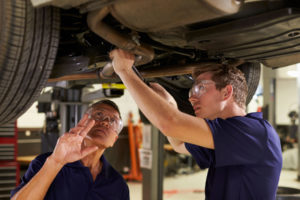The purpose of a car’s odometer is to tell you how far the vehicle has traveled. But that six-digit readout can reveal more about a used vehicle’s history and whether it’s a wise purchase.
Use 20,000 km per year as a guideline
Most drivers who use their vehicles to drive to work and take the occasional road trip will rack up about 20,000 km per year. Some easy math will tell you if a used vehicle’s odometer reading is below or above average: just divide the odometer reading by the car’s age.
A 10-year-old car with 20,000 km on it sounds like a great deal, but it’s no guarantee for longevity. In fact, it can end up being more trouble than a car with a high odometer reading.
Is a low-kilometre car a holy grail?
Many of us know someone who has bragged about a used vehicle they bought. In most versions of the story, the previous owner was an old lady who bought the car new and used it for short drives to run errands. This looks like a desirable used vehicle on paper, but the reality may be different.
- Short drives are hard on a car, and should be considered “severe” use, according to the manufacturer’s maintenance recommendations. These quick trips don’t allow the engine to reach its optimal operating temperature, causing condensation that dilutes the oil and reduces its effectiveness. If you’ve ever removed the oil cap and found what looks like chocolate milkshake on it, that’s the result of condensation.
- In addition, oil degrades over time whether the car is driven or not.
- In a rarely-driven car, engine oil and coolant and transmission fluid should be changed according to the manufacturer’s severe use maintenance schedule. That will have guidelines for all the car’s other vital fluids, too.
Make an exhaustive inspection
Short drives can also cause condensation in a car’s exhaust system. That causes the exhaust piping to rust from the inside out, creating holes that can allow harmful gases into the car. That moisture can also affect emissions-control sensors in the exhaust stream, as well as the catalytic converter.

A battery of tests
Car batteries don’t react well to sitting for long periods. Over time, a car battery loses its charge, and short drives may not be enough for the alternator to keep the battery fully charged. A weak battery will be most obvious in winter, as it may not have enough power to start the car on a cold morning. Car batteries are not especially expensive to replace, but a bad one can leave you stranded.

Rubber parts need attention too
Most of us replace our vehicle’s tires when the tread wears out. However, rubber dries out over time, compromising performance and making tires more prone to blowouts. If you’re considering a low-kilometre car, inspect the tires closely. Even if there’s enough tread to be safe, tiny cracks in the sidewalls or at the edges of the tread mean the tires should be replaced.

- Rubber also makes up many other important car parts. An engine’s cooling system is pressurized, so old radiator hoses can burst. A dried-out serpentine belt can break and leave you stranded. In addition, if the car has a rubber timing belt, that too can fail, and potentially cause serious engine damage.
- Rubber protects suspension and steering components like tie rods, ball joints and drive shaft boots. Damaged rubber lets dirt and water into these parts, which accelerates wear.
- There are also rubber seals in the engine and transmission to keep oil, fuel and other fluids from leaking out. Even if there are no leaks when you buy the car, these seals may not hold up if you begin driving the car every day.
There’s no reason to avoid a high-kilometre car
If a car’s odometer reading is much higher than the 20,000/year average, chances are that car has been mostly highway driven. Just as a car with low kilometres can be too good to be true, a high-kilometre vehicle can be a smart choice.
- It can signify less wear and tear on parts like the brakes, suspension, and transmission.
- It also suggests longer drives, which means the engine gets up to temperature for extended periods.
- If the previous owner has followed the manufacturer’s maintenance schedule, the car has visited the shop multiple times every year. That makes it more likely a mechanic will be able to repair a potential problem before it causes a breakdown.
The end of the road
A car’s odometer reading is worthy of consideration, but it doesn’t tell the whole story. Instead, focus on how the car has been maintained. Detailed maintenance records are ideal, but if the seller doesn’t have them, a good mechanic will tell you if the car is worth buying.


